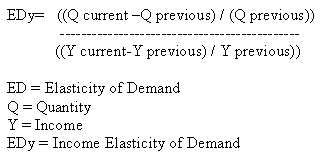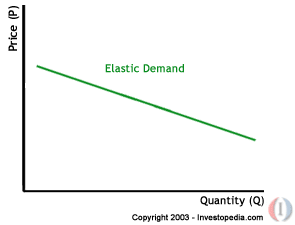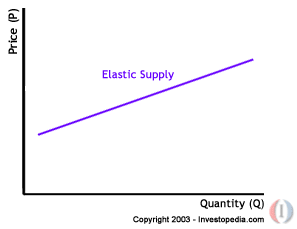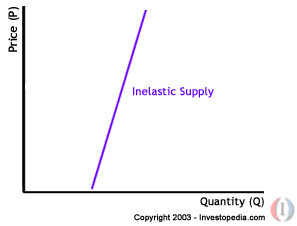We’ve seen that the demand and supply of goods react to changes in
price, and that prices in turn move along with changes in quantity.
We’ve also seen that the utility,
or satisfaction received from consuming or acquiring goods diminishes
with each additional unit consumed. The degree to which demand or supply
reacts to a change in price is called elasticity.
Elasticity varies from product to product because some products may
be more essential to the consumer than others. Demand for products that
are considered necessities is less sensitive to price changes because
consumers will still continue buying these products despite price
increases. On the other hand, an increase in price of a good or service
that is far less of a necessity will deter consumers because the
opportunity cost of buying the product will become too high.
A good or service is considered highly elastic if even a slight
change in price leads to a sharp change in the quantity demanded or
supplied. Usually these kinds of products are readily available in the
market and a person may not necessarily need them in his or her daily
life, or if there are good substitutes. For example, if the price of Coke rises, people may readily switch over to Pepsi. On the other hand, an inelastic
good or service is one in which large changes in price produce only
modest changes in the quantity demanded or supplied, if any at all.
These goods tend to be things that are more of a necessity to the
consumer in his or her daily life, such as gasoline.
To determine the elasticity of the supply or demand of something, we can use this simple equation:
| Elasticity = (% change in quantity / % change in price) |
If the elasticity is greater than or equal to 1,
the curve is considered to be elastic. If it is less than one, the
curve is said to be inelastic.
As we saw previously, the demand curve has a negative slope. If a
large drop in the quantity demanded is accompanied by only a small
increase in price, the demand curve will appear looks flatter, or more
horizontal. People would rather stop consuming this product or switch to
some alternative rather than pay a higher price. A flatter curve means
that the good or service in question is quite elastic.
Meanwhile, inelastic demand can be represented
with a much steeper curve: large changes in price barely affect the
quantity demanded.
Elasticity of supply works similarly. If a change in price results in a
big change in the amount supplied, the supply curve appears flatter and
is considered elastic. Elasticity in this case would be greater than or
equal to one.The elasticity of supply works similarly to that of demand.
Remember that the supply curve is upward sloping. If a small change in
price results in a big change in the amount supplied, the supply curve
appears flatter and is considered elastic. Elasticity in this case would
be greater than or equal to one.
On the other hand, if a big change in price only
results in a minor change in the quantity supplied, the supply curve is
steeper and its elasticity would be less than one. The good in question
is inelastic with regard to supply.
Factors Affecting Demand Elasticity
There are three main factors that influence a good’s price elasticity of demand:
1. Availability of Substitutes In general, the more
good substitutes there are, the more elastic the demand will be. For
example, if the price of a cup of coffee went up by $0.25, consumers
might replace their morning caffeine fix with a cup of strong tea. This
means that coffee is an elastic good because a small increase in price
will cause a large decrease in demand as consumers start buying more tea
instead of coffee.
However, if the price of caffeine itself were to go up, we would
probably see little change in the consumption of coffee or tea because
there may be few good substitutes for caffeine. Most people in this case
might not willing to give up their morning cup of caffeine no matter
what the price. We would say, therefore, that caffeine is an inelastic
product. While a specific product within an industry can be elastic due
to the availability of substitutes, an entire industry itself tends to
be inelastic. Usually, unique goods such as diamonds are inelastic
because they have few if any substitutes.
2. Necessity As we saw above, if something is needed
for survival or comfort, people will continue to pay higher prices for
it. For example, people need to get to work or drive for any number of
reasons. Therefore, even if the price of gas doubles or even triples,
people will still need to fill up their tanks.
3. Time The third influential factor is time. If the
price of cigarettes goes up $2 per pack, a smoker with very few
available substitutes will most likely continue buying his or her daily
cigarettes. This means that tobacco is inelastic because the change in
price will not have a significant influence on the quantity demanded.
However, if that smoker finds that he or she cannot afford to spend the
extra $2 per day and begins to kick the habit over a period of time, the
price elasticity of cigarettes for that consumer becomes elastic in the
long run.
Income Elasticity of Demand
Income elasticity of demand
is the amount of income available to spend on goods and services. This
also affects demand since it regulates how much people can spend in
general. Thus, if the price of a car goes up from $25,000 to $30,000 and
income stays the same, the consumer is forced to reduce his or her
demand for that car. If there is an increase in price and no change in
the amount of income available to spend on the good, there will be an
elastic reaction in demand: demand will be sensitive to a change in
price if there is no change in income. It follows, then, that if there
is an increase in income, demand in general tends to increase as well.
The degree to which an increase in income will cause an increase in
demand is called the “income elasticity of demand,” which can be
expressed in the following equation:
 |
If EDy is greater than 1, demand for the item is
considered to have a high income elasticity. If EDy is less than 1,
demand is considered to be income inelastic. Luxury items usually have
higher income elasticity because when people have a higher income, they
don't have to forfeit as much to buy these luxury items. As an example,
consider what some consider a luxury good: vacation travel. Bob has just
received a $10,000 increase in his salary, giving him a total of
$80,000 per year. With this new higher purchasing power, he decides that
he can now afford to go on vacation twice a year instead of his
previous once a year. With the following equation we can calculate
income demand elasticity:
Income elasticity of demand for Bob's air travel is 7, which is highly elastic.
With some goods and services, we may actually notice a decrease in
demand as income increases. These cases often involve goods and services
considered of inferior quality that will be dropped by a consumer who
receives a salary increase. An example may be the decrease in going out
to fast food restaurants as income increases, which are generally
considered to be of lower quality that other dining alternatives.
Products for which the demand decreases as income increases have an
income elasticity of less than zero. Products that witness no change in
demand despite a change in income usually have an income elasticity of
zero. These goods and services are considered necessities and are
sometimes referred to as Giffin Goods.
Another anomaly in elasticity occurs when the demand for something
increases as its price rises. We’ve learned that if the price of
something goes up, people will demand less – but certain luxury or
status items may be demanded because they are expensive. For example,
designer label clothing or accessories or luxury car brands signal
status and prestige. A work of art, a personal chef, or a diamond ring
all may be in high demand precisely because they are expensive. These
types of goods are referred to as Veblen Goods.






